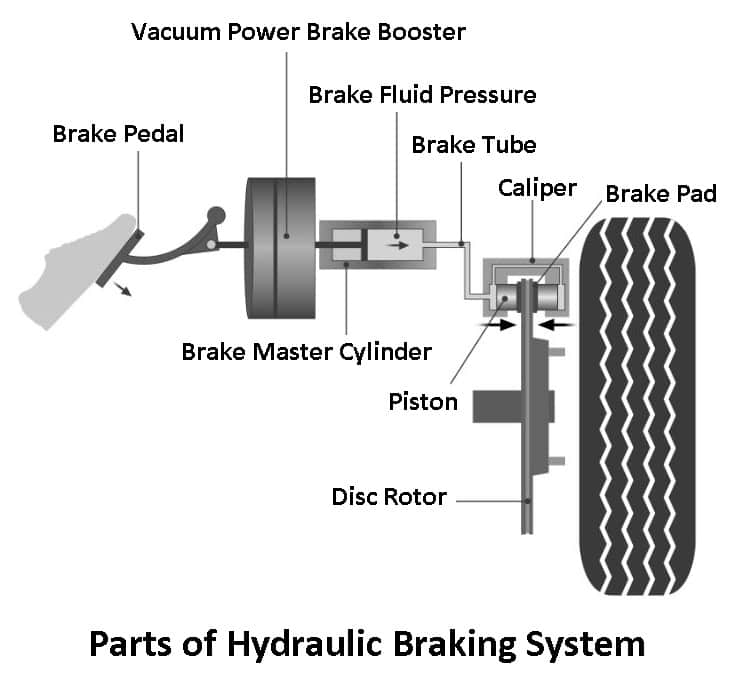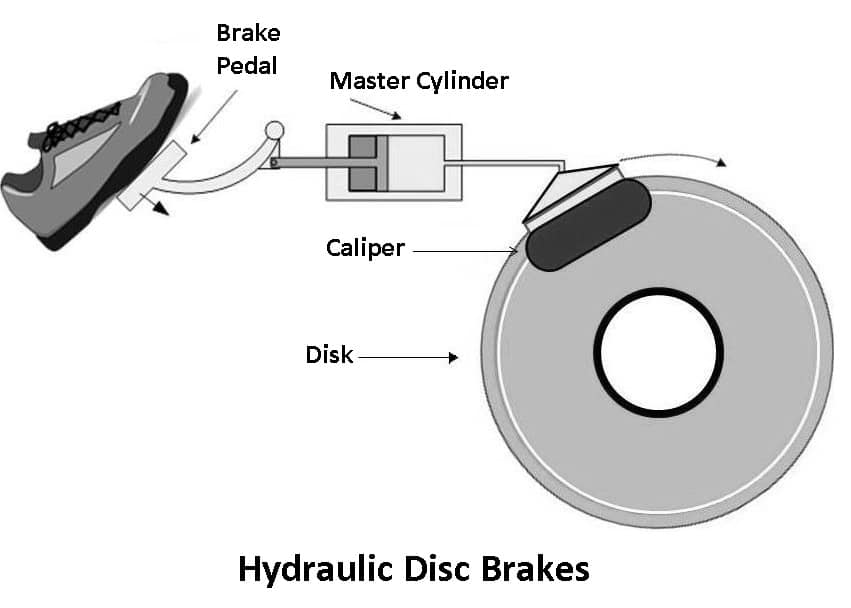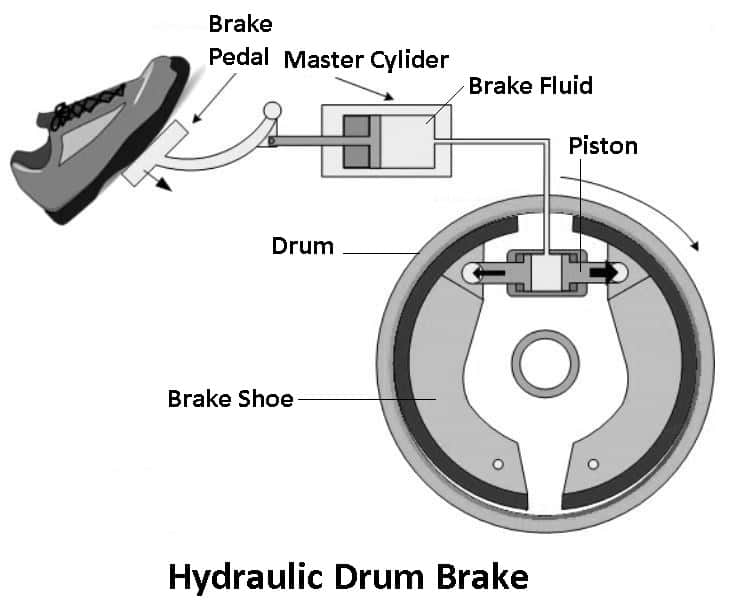In this article, you’ll learn what is hydraulic braking system? Its diagram, parts, working, advantages, and applications all are explained with pictures.
Also, you can download the PDF file at the end of this article.
What is a Hydraulic Braking System?
A hydraulic system uses liquid under pressure to transfer force, move an object, or increase its force. The fluid pressure is known as hydraulic pressure. Brakes that are operated using hydraulic pressure are called hydraulic brakes.
This type of braking system transfers pressure from the controlling mechanism to the braking mechanism using brake fluid, usually glycol ether. The first four-wheel hydraulic brake system for a motor car was developed and installed by Ernest Walter Weight in 1908.
The drum type of hydraulic braking system is primarily found in low-speed four-wheelers, while the disc type of hydraulic brakes is used in almost all cars. In addition, some types of motorcycles also use these brakes.
Hydraulic brakes are entirely dependent on the principle of Pascal’s law. “The pressure exerted anywhere in a confined liquid is transmitted undiminished in all directions” this is what the Pascal law states. Let’s understand its parts and functions.
Read Also: Common Brake Problems That Every Driver Should Know
Parts of Hydraulic Braking System
Following are the essential parts of hydraulic braking system:
- Brake pedal
- Master cylinder
- Wheel cylinder
- Brake fluid reservoir
- Hydraulic lines & hose
- Brake calipers
- Brake fluid
- Drum brake
- Disc brake

#1 Brake Pedal
The whole braking assembly will start working when the brake pedal is pressed. When the driver applies force on the brake pedal, the movement of the vehicle slows down or stops.
The pedal is connected to the master cylinder with a mechanical contact, such as a spring. After the action of the brake pedal, the master cylinder comes into play.
#2 Master Cylinder
This is the key part of the system that converts the pressure on the brake pedal into hydraulic pressure. A master cylinder performs multiple functions, including developing pressure, equalizing the brake pressure, preventing contaminants, etc.
In this, the fluid is compressed and pressurized into the cylinder, which is transmitted via hydraulic lines to the brake assembly. The master cylinder consists of various parts such as a reservoir, piston, rubber cup, pressure check valve, and more.
#3 Wheel Cylinder
This device converts hydraulic pressure into mechanical pressure to push the brake shoes towards the drum. The wheel cylinder is located in each wheel and is usually located at the top of the wheel, above the shoe.
Its function is to force the shoes into contact with the drum and protect the vehicle from friction. There are two main types of wheel cylinders: stepped wheel cylinders and single-piston wheel cylinders.
#4 Brake Fluid Reservoir
The brake fluid reservoir stores and protects the vehicle’s brake fluid so the braking system can function correctly. The storage is usually small and is connected directly to the master cylinder for proper operation of hydraulic braking.
There must be a sufficient amount of braking fluid throughout the assembly. In some cases, due to small leaks, the brake fluid level drops in the master cylinder. Therefore, a reservoir is required to maintain the proper level.
#5 Hydraulic Lines & Hose
The brake line and hose transfer high-pressure fluid between the various components. Simply put, they are like pipes in which the braking fluid passes from the master cylinder to the brakes. Brake lines are rigid and constructed using double-wall steel tubing.
#6 Brake Calipers
The brake caliper is an essential part found in a disc brake system. Its function is to hold and guide the brake pads. Also, it converts hydraulic pressure in the brake system into mechanical force by using one or more pistons.
#7 Brake Fluid
Modern cars use brake fluid as a liquid chemical solution for hydraulic braking. It is this medium that transfers pressure to the wheel cylinders. Hydraulic brake fluid must have a low freezing point, high boiling point, lubrication, non-corrosiveness, and proper viscosity.
Read Also: Essential Parts of Car Wheel Assembly [Functions Explained]
Construction of Hydraulic Braking System
The constructional arrangement of hydraulic brakes consists of various parts such as the brake pedal or level, a pulley, also known as an actuating rod, and a piston in a master cylinder assembly.
The master cylinder includes one or two pistons, a return spring, a series of gaskets or O rings, and a fluid reservoir. In addition, it also featured reinforced hydraulic lines and brake caliper assembly. The brake caliper assembly consists of one or two hollow aluminum pistons (called caliper pistons), a set of thermally conductive brake pads, and a brake disc.
It is usually filled with glycol-ether brake fluid, though other fluids can also be used. At one time, passenger vehicles usually had drum brakes on all four wheels. Generally, disc brakes are used for the front wheels, while drum brakes are used for the rear wheels.
Read Also: Different Types of Tires for Cars and Their Purposes
Working of Hydraulic Braking System
The working of the hydraulic braking system is straightforward. To understand the function of these brakes, let’s consider disc brake and drum brake. In both types, initial work is similar, but performance styles differ.
When using disc brakes, the brake calipers and discs apply the brake, whereas when using drum brakes, the brake shoes and drums apply the brake. Let us understand the working of these two brakes in detail.
#1 Hydraulic Disc Brake

Disc hydraulic brakes work by applying pressure or force on the brake pedal. This action generates compressive force, which causes the brake fluid to be compressed into the master cylinder through a piston-cylinder arrangement.
In the system, the hydraulic fluid creates pressure in the hydraulic lines and transfers this pressure to the disc brake calipers, between which the disc is mounted. Both the brake calipers consist of a piston arrangement. Brake pads are mounted on pistons.
When the brake pedal is pressed, both pistons start moving towards the disc. Finally, the brake caliper compresses the disc, and the brake is applied, which means that the moving parts cease to move. Upon releasing the brake pedal, the hydraulic pressure in the lines drops, and the pistons in the calipers move outward, thus releasing the brakes.
#2 Hydraulic Drum Brakes

In the beginning, the working of the drum brake and disc brake is the same. The main difference lies in the performance of these brake types. Whenever the driver applies the brakes, the piston will be pushed inside the master cylinder by the connecting rod that connects the pedal to the piston.
When this fluid starts moving, it causes compression of the brake fluid inside the master cylinder. Due to this, it expands and converts mechanical energy into hydraulic pressure. In the end, it converts the kinetic energy of the vehicle into heat energy, and the vehicle completely stops moving.
Read Also: Drum Brake vs. Disc Brake: What’s the Difference?
Specifications of Hydraulic Brakes
The following performance specifications should be taken into account when choosing a hydraulic brake:
#1 Torque Rating
It is recommended that the brake’s maximum torque rating matches or exceeds the requirements of the application.
#2 Power
For hydraulic brakes, it is a measure of their maximum power.
#3 Speed
This specification applies only to rotary brakes and represents the maximum rotary speed.
#4 Maximum Pressure
For hydraulic brakes, it is the maximum pressure.
#5 Shaft Configuration
Depending on the application, the brake may be mounted in-line, parallel, or at an angle.
Read Also: What is the function of Wankel Rotary Engine?
Advantages of Hydraulic Braking System
- Hydraulic disc brakes provide more braking power.
- These brakes have a large contact area, which supports heat dissipation.
- Hydraulic brakes rarely fail, making them reliable at high speeds.
- These brakes work better in wet and muddy conditions than mechanical brakes.
- Since it is a hydraulic system, it includes power, accuracy, efficiency, and ease of maintenance.
Disadvantages of Hydraulic Braking System
- They have a relatively high price compared to mechanical brakes.
- The brake fluid used in the braking system must be compatible with the brake material.
- Braking fluid leakage may occur, which will result in brake failure.
- Unlike mechanical brakes, hydraulic brakes require more maintenance and construction.
Applications of Hydraulic Braking System
- These types of brakes are primarily used in cars and other automobile applications.
- Drum-type hydraulic brakes are used in some low-speed four-wheelers like trolly vehicles.
- Disc-type hydraulic brakes are used in almost all cars and also be used in bikes.
- Single-acting hydraulic brakes are used as front brakes in some types of bikes.
- Dual-acting hydraulic brakes are used in almost all vehicles.
- In addition to automotive applications, these brakes can also be seen in oil field operations.
- Additionally, it is also used in power generation stations such as wind turbines.
Conclusion
Due to their advantages and ease of use, hydraulic brake systems are becoming increasingly popular. Vehicles of all types, including automobiles, bikes, cars, and heavy trucks, are adopting this technology.
The fluid used in this system may vary according to its application. This is because heavy-duty vehicles require more pressure to apply the brakes. Currently, some of its applications can also be found in mopeds.
I hope I have covered everything about the “Hydraulic Braking System.” If I missed something, or if you have any doubts, let me know in the comments. If you liked this article, please share it with your friends.
Want free PDFs direct to your inbox? Then subscribe to our newsletter.
Download PDF of this article:
Read more on our blog:
I like to follow this page
That’s good.
This is very helpful and it is clearly understandable. I appreciate your help
Kindly asking for Notes on Exhaust brakes.
Thank you!!
I’m glad you liked it. Thanks for suggesting it. I’ll write on that topic.
Understanding guide.
Thanks for your feedback.
Very very helpful and easy to understand…The English used,is easier than other books.
Please more on automotive engineering.
Thanks for your feedback.